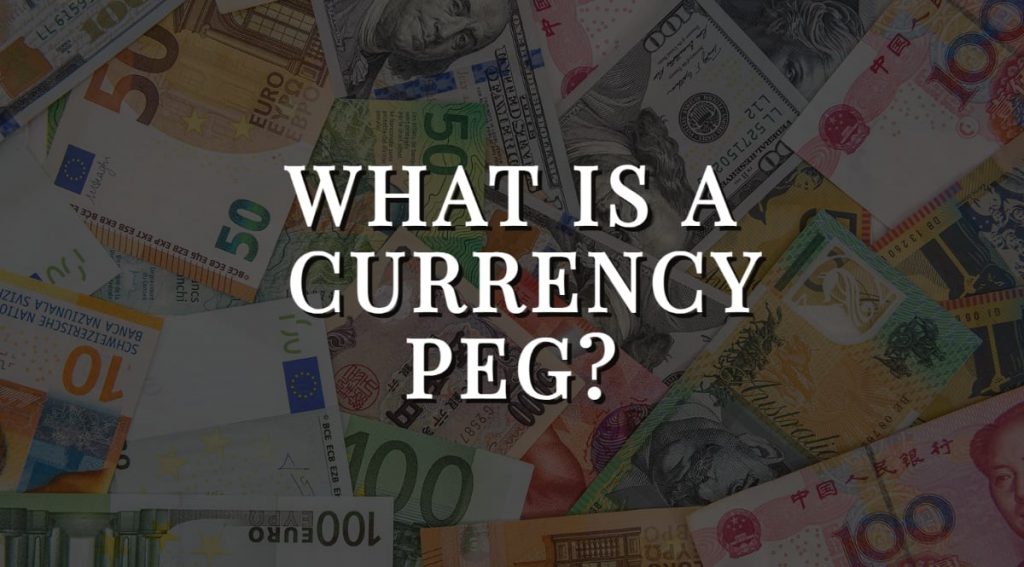
What is a currency peg and how does it work?
A currency peg is an essential tool a government uses in controlling the rate of a currency. We can also call it a fixed exchange rate system. For forex traders, knowing and understanding currency pegs is essential. They can have a very big effect on how much price variability certain currency pairs might have.
Currency exchange rates ascribe the number to the relative value of one currency to another. Many of these currencies will change depending on the prices the market sets. However, currency pegging allows for a different option, giving fixed currencies.
Defining a currency peg
The first question to tackle is: what is a currency pegging? Currency pegging is a matter of national policy. To explain it briefly, the national government tries to fix the exchange rate of its currency to that of another currency. Either a government would carry this out directly or a central bank would set this policy, depending on a country’s governmental structure. Furthermore, it is not necessary that they peg the currency to any specific foreign currency, but can peg it to a basket of currencies. This allows for greater stability, as one currency on its own could behave unexpectedly and cause sudden changes in the primary currency.
So, instead of relying on the supply and demand of a specific currency to control the price, they would hopefully follow a more stable currency. It means artificially reducing the volatility of a currency. This mechanism reduces the foreign exchange risk between any two countries. It allows for more stable trade between countries, as it makes exchange rates predictable, gives businesses assurances, and allows them to plan for future exchanges. These can remain in place for many decades if all goes according to plan. A famous example of this is the Hong Kong dollar. Hong Kong has pegged its currency to the US dollar since all the way from 1983.
There is also an alternative soft peg, which is a sort of intermediary measure. Countries will allow their currency to change according to the supply and demand of the market. However, during rapid changes, central banks will suddenly intervene to stabilize the situation.
We’ll now discuss what a peg for a currency means in the real world, and what its advantages and disadvantages are.
The main advantages of using this system
Pegging has a variety of benefits we can discuss. Especially when currencies remain stable, it assures that trade is smooth between any two states, and supply chains remain steady. It allows for a greater amount of trade and real incomes should benefit. As everything remains predictable, between two countries, businesses can be bolder with their moves and more efficient. Farmers can be more efficient, retailers have access to a wider variety of producers, and tech companies also have access to more resources for further research (in terms of both material and human capital). Therefore, overall, long-term planning and investments are the main benefits.
The main disadvantage of using a currency peg
The growth of stable trade and the size of economies is the ideal outcome, but currency pegs can also backfire. Close monitoring of currencies is necessary in order for this system to succeed. This is something a country’s central bank would usually take on. They would ensure there is sufficient cash flow, and that the supply and demand of a currency is appropriate. If they do notice sudden changes, they will have to act accordingly. Using foreign exchange reserves, they can counteract against the overselling or overbuying of a currency.
If a peg is too high, consumers will heavily rely on foreign goods, as their purchasing power will be higher. They will keep buying these goods and increase demand. Too many imports will put pressure on a currency by creating trade deficits. Central banks will have to counteract this by spending their foreign reserves. This system can keep going until the central bank runs out of foreign reserves, which is when the real problems would begin.
The peg would suddenly collapse, which will also cause the collapse of the currency. Imports will become expensive overnight. This will then mean that inflation will rise to make up for the price differences. Following inflation, they will struggle to pay their debts. The partner country will struggle with their exports, and any assets they have abroad will be worth less. So the trade relationship between the two countries could collapse.
When a peg is too low, the opposite problem may take place. Consumers in the domestic market have less purchasing power. They will therefore be able to buy less foreign goods. Their consumption will be lower, as will their standard of living. As this occurs, foreign producers exporting their goods will notice the lower demand. Their business will hurt, and they will have to reduce trade with the foreign partner. In this case, the peg reduces trade between two countries.
Conclusions
In summary then, while the benefits of a currency peg seem great, there is still some risk in using it. If the policy on the pegging of a currency is not appropriate this could hurt an economy. A peg that is too high can mean too many imports, with the aftermath of a currency collapse being inflation. A peg that is too low may disrupt the domestic living standards and cause tension between countries by hurting businesses abroad.




